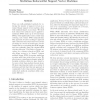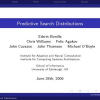121
Voted
ICML
2006
IEEE
15 years 6 months ago
2006
IEEE
There are well-established methods for reducing the number of support vectors in a trained binary support vector machine, often with minimal impact on accuracy. We show how reduce...
139
Voted
ICML
2006
IEEE
2006
IEEE
Automatic basis function construction for approximate dynamic programming and reinforcement learning
15 years 6 months ago
We address the problem of automatically constructing basis functions for linear approximation of the value function of a Markov Decision Process (MDP). Our work builds on results ...
79
Voted
ICML
2006
IEEE
15 years 6 months ago
2006
IEEE
123
Voted
ICML
2006
IEEE
16 years 1 months ago
2006
IEEE
We present a unified duality view of several recently emerged spectral methods for nonlinear dimensionality reduction, including Isomap, locally linear embedding, Laplacian eigenm...
113
Voted
ICML
2006
IEEE
16 years 1 months ago
2006
IEEE
We present a new unsupervised algorithm for training structured predictors that is discriminative, convex, and avoids the use of EM. The idea is to formulate an unsupervised versi...
111
Voted
ICML
2006
IEEE
16 years 1 months ago
2006
IEEE
Most work on preference learning has focused on pairwise preferences or rankings over individual items. In this paper, we present a method for learning preferences over sets of it...
106
Voted
ICML
2006
IEEE
16 years 1 months ago
2006
IEEE
Semi-naive Bayesian classifiers seek to retain the numerous strengths of naive Bayes while reducing error by weakening the attribute independence assumption. Backwards Sequential ...
110
Voted
ICML
2006
IEEE
16 years 1 months ago
2006
IEEE
We describe a statistical approach to software debugging in the presence of multiple bugs. Due to sparse sampling issues and complex interaction between program predicates, many g...
101
Voted
ICML
2006
IEEE
16 years 1 months ago
2006
IEEE
99
Voted
ICML
2006
IEEE
16 years 1 months ago
2006
IEEE
Ordinal regression has become an effective way of learning user preferences, but most of research only focuses on single regression problem. In this paper we introduce collaborati...



